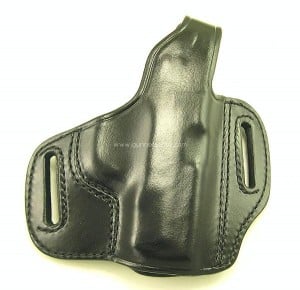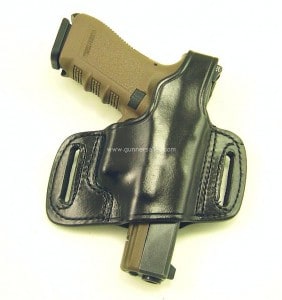The concern about a thumb break or retention device is another of the more common questions that we are asked here at Gunner’s Alley. And, given the state of things, it’s a legitimate question. Here’s how we usually address it:
The decision to utilize a thumb break (also called a retention strap, snap strap, etc.) should really be decided by a number of factors including:
Holster Use or Application – What or how will the holster be used? For example, is it just going to be used for daily CCW or will you be wearing it hiking as well? If you are planning on wearing the holster during physical activity (jogging, hiking, etc.), then it might make sense depending on personal preferences.
Experience or Level of Comfort – We typically see a significant concern for gun retention in less experienced or people newer to CCW. While gun retention is certainly extremely important, most or many of the main risks can be mitigated with some training and range time with a holster. The idea that a thumb break automatically equates to a higher level of handgun retention is comforting, but not completely true. Especially considering the fact that many law enforcement officers shot in the line of duty are shot with their own weapon. With new shooters or CCW’ers, the concern that the pistol just “pops” out of the holster seems to be more of a concern than actual handgun retention during an altercation.
The Necessity to Train with it – Should you opt for a holster using a thumb break or other retention device, it’s absolutely imperative that you train or work with the holster in live fire scenarios to condition your body how to draw under stress. While this approach is true of most any holster, it’s especially true if you are transitioning from an open top holster without any retention devices to a holster with a retention device. In times of stress, your body will try to draw the way you have practiced. If you haven’t practiced with the new holster with a retention device, you may not be able to draw it.
Trust me, I’ve been there on this one. During my law enforcement days, I spent 6 years on patrol carrying a duty weapon in a level 2 retention holster on my strongside. When I moved into Investigations, I decided to try a shoulder holster out as it seemed a more comfortable option given the plainclothes assignment. I purchased a shoulder holster and went to qualify with it. The lead range officer put me through some drills to confirm that I was comfortable with the new draw method and proficient enough to be effective with it. Two weeks later, I was involved in one of those split second scenarios where the adrenaline and tunnel vision kicked in. Instinctively, I reached to draw my weapon, but it wasn’t on my hip anymore. While the situation resolved itself without any major issues, the fact that I reached for a gun that wasn’t there and wasted even a little bit of time to draw my weapon was enough for me to scrap the shoulder holster plan and revert back to a strongside holster on my hip (where it had been for the last 6 years). So 2 things were possible there:
(1) Even though I felt comfortable with the shoulder rig, I simply didn’t practice enough to secure any muscle memory
(2) I had been carrying a sidearm on my hip so long that drawing from that position was basically ingrained in my subconscious.
Either way, I learned a lesson that I carry with me to this day.
So is a holster with a thumb break or retention device in your future? That’s up to you, but give some thought to it before you make that decision.



1 thought on “Should I Get a Holster With a Thumb Break?”